The Hi-Fi Show – London ’99
| Event – The Hi-Fi Show – London ’99 |
| Adnan Arduman |
| 10 October 1999 |
I visited the show during its first two trade days: 23-24 September 1999. It took place at Novotel in Hammersmith, London.
Most of the exhibitors were European, the majority of them being British companies. Compared with the London show that I had visited in 1996, I was under the impression that there were less participants, but I found that the general sonic quality was surprisingly high. London 99 was quality rather than quantity.
Please read my commentary below, having the following in mind:
-
Due to the adverse acoustical (and other) conditions of the show, this is not an absolute review but just my impressions.
-
I only covered the rooms which seemed either original or interesting or showed a new product.
-
I automatically skipped all rooms with a screen (white or plasma) between the two speakers.
-
I always tried to judge using my own CDs, which were:
R. Strauss / Violin Sonatas / Chung, Zimerman / DG427 617-2
Keith Jarrett Trio / Bye Bye Blackbird / ECM 1467 513 074-2
Saint-Saens / Symphony No.3 / BPO, Levine / DG419 617-2
-
I was listening to systems and not to components and therefore, if my impressions are favourable, this may mean that either all the components are sounding good or the synergy is good. In the opposite case, either one or more than one components are sounding poor or the synergy is poor.
Quad
 Quad were displaying their top-of-the-line ESL-989 speakers (looks like a taller version of ESL-63). These speakers will be on the market in two months time and will retail for 4000.- Sterling. The famous and my long time favourite ESL-63 speakers have been apparently discontinued 18 months ago.
Quad were displaying their top-of-the-line ESL-989 speakers (looks like a taller version of ESL-63). These speakers will be on the market in two months time and will retail for 4000.- Sterling. The famous and my long time favourite ESL-63 speakers have been apparently discontinued 18 months ago.
 I first listened to the speakers with Quad’s solid-state electronics. The sound seemed very decent with a touch of dryness probably coming from the SS amps, then for some reason the CD player didn’t want to play my Keith Jarrett CD and we had to switch to another player connected to Quad’s prototype tube amps. And glory! The sound became much more musical with meat on the mids (instead of bone). It was a little on the euphonic side and lacked some resolution though.
I first listened to the speakers with Quad’s solid-state electronics. The sound seemed very decent with a touch of dryness probably coming from the SS amps, then for some reason the CD player didn’t want to play my Keith Jarrett CD and we had to switch to another player connected to Quad’s prototype tube amps. And glory! The sound became much more musical with meat on the mids (instead of bone). It was a little on the euphonic side and lacked some resolution though.
Having the same virtues of their predecessors, Quad’s new speakers seemed very promising: they had more low frequency extension, but the high frequency roll-off seemed to be at the same point as the ESL-63s.
ProAc
 ProAc were displaying their brand new top-of-the-line two new speakers: Future 1 (shorter) and Future 2 (taller). They feature a ribbon tweeter, dipole midrange and asymmetric bass chamber.
ProAc were displaying their brand new top-of-the-line two new speakers: Future 1 (shorter) and Future 2 (taller). They feature a ribbon tweeter, dipole midrange and asymmetric bass chamber.
Both speakers were sounding good, open and detailed. I preferred the Future 2 which had a much more relaxed sound. Its bass was very detailed and controlled but in this room it did not seem to have the necessary extension.
 Stuart Tyler (on the picture), owner and designer of ProAc told me that the German market was no longer interested in these classical prismatic speakers, but needed something different and therefore he came up with the Future range. He also told me that the speakers are brand new and therefore not broken-in. Unfortunately I have difficulty understanding this: how can any exhibitor participate in the show with equipment not broken-in. Believe me there were many such examples in this exhibition. ProAc Future speakers still sounded good, so I guess they will sound great once broken-in.
Stuart Tyler (on the picture), owner and designer of ProAc told me that the German market was no longer interested in these classical prismatic speakers, but needed something different and therefore he came up with the Future range. He also told me that the speakers are brand new and therefore not broken-in. Unfortunately I have difficulty understanding this: how can any exhibitor participate in the show with equipment not broken-in. Believe me there were many such examples in this exhibition. ProAc Future speakers still sounded good, so I guess they will sound great once broken-in.
Tron Amps – Avantgarde Speakers
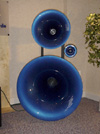 I’ve listened to Avantgarde’s top speaker called Trio driven by Tron’s 300B Single Ended stereo amplifier.
I’ve listened to Avantgarde’s top speaker called Trio driven by Tron’s 300B Single Ended stereo amplifier.
 Tonally they seemed much more satisfying than what I had heard three years ago (driven with a Audio Note UK amp at that time), but after a while, I started to notice a certain weirdness in the cymbals (I guess I should call it coloration) and euphony on the mids. Bass seemed extended but loose. Not for people who give priority to neutrality.
Tonally they seemed much more satisfying than what I had heard three years ago (driven with a Audio Note UK amp at that time), but after a while, I started to notice a certain weirdness in the cymbals (I guess I should call it coloration) and euphony on the mids. Bass seemed extended but loose. Not for people who give priority to neutrality.
Beauhorn
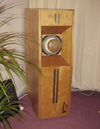 These speakers were originally called “Bravura”. Their designer Eric Thomas told me that this has been a trademark issue with another company and he had to rename the brand as Beauhorn. The particular speakers I’ve listened were called Virtuoso’s.
These speakers were originally called “Bravura”. Their designer Eric Thomas told me that this has been a trademark issue with another company and he had to rename the brand as Beauhorn. The particular speakers I’ve listened were called Virtuoso’s.
Virtuoso’s are using Lowther DX4 drivers and are horn loaded for the low frequencies. The efficiency is 105dB/W/m. They were driven with 3W Single Ended “no-name” prototype mono amps.
This was one of the very good sounds of the show: natural, untiring, relaxed, good inner resolution. Mids were full and the bass was very satisfactory. There was only a slight roll-off on the treble side. But overall a very pleasant sound indeed.
Zingali
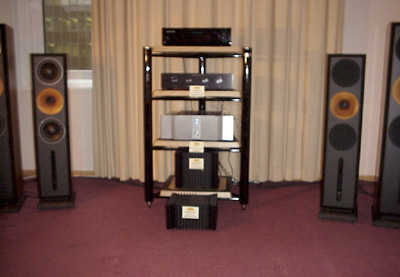 I listen to Zingali’s Overture 3B model speakers driven by Pass Aleph amplification.
I listen to Zingali’s Overture 3B model speakers driven by Pass Aleph amplification.
Although the bass was a little dry, my overall impression was very positive.
Odeon Speakers – CR Developments Amps
 I listened to Odeon Tosca speakers using plywood horn and having 94dB/W/m efficiency. Their bass is tuneable to suit the room acoustics.
I listened to Odeon Tosca speakers using plywood horn and having 94dB/W/m efficiency. Their bass is tuneable to suit the room acoustics.
 The sound was natural and pleasant, but with a hint of boxiness. I also found that they were not very suitable for orchestral music. I think the bigger Odeon speakers will be more successful in this respect.
The sound was natural and pleasant, but with a hint of boxiness. I also found that they were not very suitable for orchestral music. I think the bigger Odeon speakers will be more successful in this respect.
I could not refrain myself from taking the picture of the beautifully made Einstein CD Player with tubes.
Totem
 I listened to Totem Forest speakers driven with Sugden 65W solid-state amplifiers.
I listened to Totem Forest speakers driven with Sugden 65W solid-state amplifiers.
As I knew how well Totem speakers sound, I was surprised by the slightly edgy mids. This was most probably due to poor SS amplification. On the positive side, I can pronounce airiness and openness, especially when the little aluminium “beaks” are in their place on top of the speakers. These “beaks” so much amazed me that I bought two pairs to try on my ProAc 3.8s. A review is in order.
Hornutopia
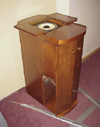 This speaker has a very peculiar cabinet that looks like real furniture. Close the top, and no one would guess that it’s a speaker. Ideal for wives with low tolerance for our hobby (infinite WAF). The Lowther DX-4M driver fires to the ceiling thus providing a 360 degrees dispersion. They were driven by Audio Note (UK) P1SE stereo amp.
This speaker has a very peculiar cabinet that looks like real furniture. Close the top, and no one would guess that it’s a speaker. Ideal for wives with low tolerance for our hobby (infinite WAF). The Lowther DX-4M driver fires to the ceiling thus providing a 360 degrees dispersion. They were driven by Audio Note (UK) P1SE stereo amp.
Unfortunately the sound is not as good as the looks. Lean, tiring, edgy, bright, lacking bass extension. On the positive side I can state they had good inner detail.
Synthesis Amps – Diapason Speakers
 Colourful, well finished “push-pull” amplifiers from Italy were driving the monitor like Diapason speakers.
Colourful, well finished “push-pull” amplifiers from Italy were driving the monitor like Diapason speakers.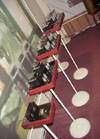
Decent, natural and detailed sound with no bass extension as you might have guessed from the size of the speakers.
Ear / Yoshino
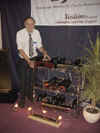 Everything in this room with the exception of Quad ESL-63 speakers were designed by the famous designer, Tim de Paravicini (see picture). Quads were complemented by de Paravicini’s subwoofers and crossover and were driven in bi-amp configuration by his push-pull Ear / Yoshino tube amps.
Everything in this room with the exception of Quad ESL-63 speakers were designed by the famous designer, Tim de Paravicini (see picture). Quads were complemented by de Paravicini’s subwoofers and crossover and were driven in bi-amp configuration by his push-pull Ear / Yoshino tube amps.
As a person who has experimented with Gradient subwoofers on the Quads (with no success), I can easily state that Tim de Paravicini did a great job here. Good integration and coherence. You really don’t feel that there is a subwoofer on the circuit. In such configuration the Quads were sounding very good with full bodied mids, only the usual Quad weakness remained: treble lacking extension and detail.
“If I can’t do the best in the World, I don’t do it” said Tim de Paravicini. He must be right.
Musical Fidelity Electronics – Sonus Faber Guarneri Speakers
 Musical Fidelity’s new model electronics were driving the famous Guarneri’s.
Musical Fidelity’s new model electronics were driving the famous Guarneri’s.
Although there was the usual small speaker weakness on the bass and a slight overall leanness, I liked the natural and detailed sound. A very good synergy.
Evett & Shaw
 When I entered this room, I recognized Ray Kimber who was acting as a person manning the stand.
When I entered this room, I recognized Ray Kimber who was acting as a person manning the stand.  I looked at the cables and could see that the speaker cables were from Kimber, but this wasn’t the reason for Ray Kimber’s presence. He told me that the particular speakers made by Evett & Shaw were using “Dopler Cancelling System” patented by Kimber Cable. He gave me a detailed explanation about what that means which I will summarize as: “thanks to this system a three way speaker is acting as a full range single unit”. He also told me that Cary is now working on a new speaker using this system. The sound I heard was natural and well extended in both ends, but a little electronic. The picture shows Craig Pease (Evett & Shaw), left and Ray Kimber on the right.
I looked at the cables and could see that the speaker cables were from Kimber, but this wasn’t the reason for Ray Kimber’s presence. He told me that the particular speakers made by Evett & Shaw were using “Dopler Cancelling System” patented by Kimber Cable. He gave me a detailed explanation about what that means which I will summarize as: “thanks to this system a three way speaker is acting as a full range single unit”. He also told me that Cary is now working on a new speaker using this system. The sound I heard was natural and well extended in both ends, but a little electronic. The picture shows Craig Pease (Evett & Shaw), left and Ray Kimber on the right.
Kondo – Marshall
 Mr. Hiroyasu Kondo (picture below), designer of the famous ONGAKU, owner of Audio Note (Japan) company, the legendary figure of the single-ended amplifiers was standing in front of me. Four years ago, I had read his article in Sound Practices magazine and was very impressed. So now I was very excited to meet him.
Mr. Hiroyasu Kondo (picture below), designer of the famous ONGAKU, owner of Audio Note (Japan) company, the legendary figure of the single-ended amplifiers was standing in front of me. Four years ago, I had read his article in Sound Practices magazine and was very impressed. So now I was very excited to meet him.
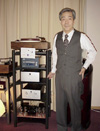 I was surprised to learn from him (through translation) that Audio Note – Japan has no relation at all with Audio Note – UK. I felt that this issue was very sensitive and if I could understand correctly they were talking about a legal case between them.
I was surprised to learn from him (through translation) that Audio Note – Japan has no relation at all with Audio Note – UK. I felt that this issue was very sensitive and if I could understand correctly they were talking about a legal case between them.
There were two rooms side by side, both called “Kondo – Marshall”, one displaying Marshall guitar amplifiers and the other Kondo brand amplifiers. I learned that the two companies had recently signed a Joint Venture agreement. Thus Marshall will enter the UK Hi-End market backed-up with Kondo’s expertise on the subject. They are already both using tubes anyhow. I wish them good luck.
In Kondo’s room 2A3 Push-Pull amplifier was driving B&W Nautilus speakers. The sound was natural but a bit lean to my taste.
Carfrae Speakers
 These original and beautiful looking speakers are using the Lowther DX-4 drivers. The horn shape helps to boost the bass of this single full range driver. There was an optional sub-woofer working between 50-28Hz, and in the present configuration the sub-woofer was in place. The efficiency is 108dB/W/m.
These original and beautiful looking speakers are using the Lowther DX-4 drivers. The horn shape helps to boost the bass of this single full range driver. There was an optional sub-woofer working between 50-28Hz, and in the present configuration the sub-woofer was in place. The efficiency is 108dB/W/m.
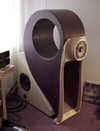 They were sounding so well that I thought my hearing was influenced by the looks and visited this room on both days. My two visits clearly confirmed that this was one of the two best sounds (or maybe “the best”) of the show. The inner details were incredible but this was not making the sound edgy or tiring. It was well extended on both ends, with excellent orchestral resolution and good focus. Dynamics were handled without any problem. And all this with a natural tonality. Congratulations Jim Carfrae (picture above).
They were sounding so well that I thought my hearing was influenced by the looks and visited this room on both days. My two visits clearly confirmed that this was one of the two best sounds (or maybe “the best”) of the show. The inner details were incredible but this was not making the sound edgy or tiring. It was well extended on both ends, with excellent orchestral resolution and good focus. Dynamics were handled without any problem. And all this with a natural tonality. Congratulations Jim Carfrae (picture above).
They were driven with a “no-name” OTL (!) single-ended amplifier using unknown (to the people in the room) TV tubes.
Linn
 Exactly the same stand was on exhibit last May in Chicago. I was not pleased with the sound and that’s why I did not include Linn in my report. Surprisingly in London the same system sounded much more pleasant, devoid of any dullness which I had heard in Chicago. It was natural, had good dynamics and detail. I guess in Chicago they had used brand new and hence unbroken-in units.
Exactly the same stand was on exhibit last May in Chicago. I was not pleased with the sound and that’s why I did not include Linn in my report. Surprisingly in London the same system sounded much more pleasant, devoid of any dullness which I had heard in Chicago. It was natural, had good dynamics and detail. I guess in Chicago they had used brand new and hence unbroken-in units.
The famous Linn CD-12 player was in the center of the system. Each Keltic speaker was driven by four (!) mono Klimax amps (each driver of the speaker with its own amplifier).
Chord Amps – Wilson Benesch Speakers
 Chord’s
Chord’s 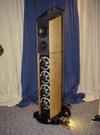 brand new SPM 4000 MOSFET mono amplifiers (480W/channel) were driving Wilson Benesch’s “The Bishop” speakers.
brand new SPM 4000 MOSFET mono amplifiers (480W/channel) were driving Wilson Benesch’s “The Bishop” speakers.
To my ears, this was without hesitation the other best sound of the show. Silky sound combined with excellent dynamics, resolution, extension, ‘staging,…. I tried to find a negative point to mention, but couldn’t. The system did not at all sound “solid-state”, it did not have a specific character and was totally colourless. Maybe, if I force myself too much, I can say, in a pedantic way, that it lacked the “je ne sais quoi” (or the magic) of the Carfrae system.
Bravo Chord and Wilson Benesch!!!
Avalon Speakers – Conrad-Johnson Electronics
 Avalon Opus speakers were driven by Conrad-Johnson’s MF-2500 new solid- state power amplifier.
Avalon Opus speakers were driven by Conrad-Johnson’s MF-2500 new solid- state power amplifier.
 The room was very crowded and there was a lot of chatting going on, so it was very difficult to judge the sonic qualities of the system. I still could detect a very natural and good sound, though it was a little lean and dry. The bass was not much extended but very well defined and controlled.
The room was very crowded and there was a lot of chatting going on, so it was very difficult to judge the sonic qualities of the system. I still could detect a very natural and good sound, though it was a little lean and dry. The bass was not much extended but very well defined and controlled.
I also wanted to take the picture of the beautiful looking Kuzma turntable.
Spectral Amps – Verity Audio Speakers
 Spectral DMA-100S stereo power amplifier was driving Verity Audio’s Parsifal speakers.
Spectral DMA-100S stereo power amplifier was driving Verity Audio’s Parsifal speakers.
It was again a natural but lean sound. Detailed but a bit edgy and hard, with limited bass extension.
Loth X Audio
 Loth X Audio’s Azimuth speakers have a Lowther looking drivers. They told me that they are not Lowthers, but their own drivers working in the same principle. They also had their own electronics and the Silbatone preamplifier was battery powered. The power amps were 2A3 single-ended prototypes.
Loth X Audio’s Azimuth speakers have a Lowther looking drivers. They told me that they are not Lowthers, but their own drivers working in the same principle. They also had their own electronics and the Silbatone preamplifier was battery powered. The power amps were 2A3 single-ended prototypes.
I found the sound to be natural but a bit clinical and lean with limited bass response.
Van Den Hul
 Mr. van den Hul was “driving” B&W speakers with his 100% carbon and top-of-the-line speaker cable called: “The Third”. Although a bit (or a lot?) on the resistive side, he believed in carbon and gave me a speech about their virtue. Using a van den Hul carbon hybrid speaker cables (The Revelation) I believed him.
Mr. van den Hul was “driving” B&W speakers with his 100% carbon and top-of-the-line speaker cable called: “The Third”. Although a bit (or a lot?) on the resistive side, he believed in carbon and gave me a speech about their virtue. Using a van den Hul carbon hybrid speaker cables (The Revelation) I believed him.
WBT
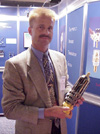
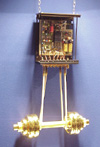 WBT’s sales manager Jochen Rueger is looking for a suitable size female for his XXXL plug.
WBT’s sales manager Jochen Rueger is looking for a suitable size female for his XXXL plug.
A team of four normal size RCA-plugs won the weight lifting championship of the show and still carry their prize, which was a golden weight.
![]()
Don’t forget to bookmark us! (CTRL-D)
Stereo Times Masthead
Publisher/Founder
Clement Perry
Editor
Dave Thomas
Senior Editors
Frank Alles, Mike Girardi, Russell Lichter, Terry London, Moreno Mitchell, Paul Szabady, Bill Wells, Mike Wright, and Stephen Yan,
Current Contributors
David Abramson, Tim Barrall, Dave Allison, Ron Cook, Lewis Dardick, John Hoffman, Dan Secula, Don Shaulis, Greg Simmons, Eric Teh, Greg Voth, Richard Willie, Ed Van Winkle, and Rob Dockery
Site Management Clement Perry
Ad Designer: Martin Perry





Be the first to comment on: The Hi-Fi Show – London ’99